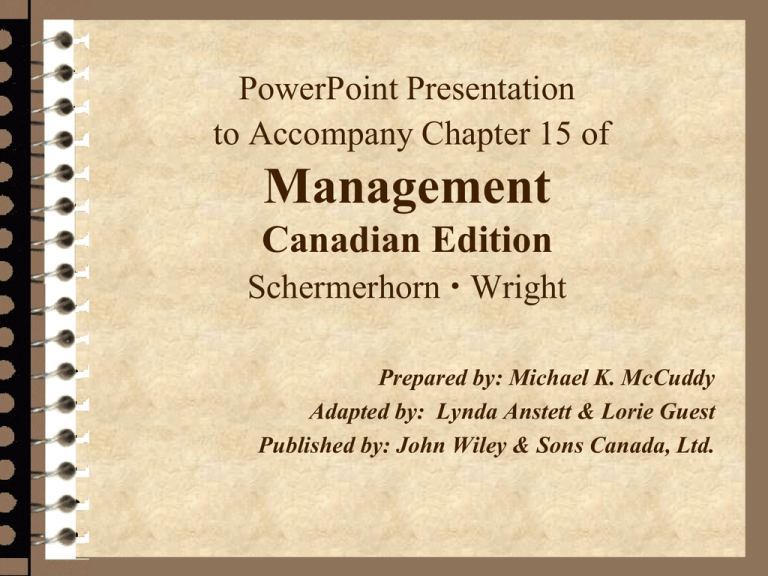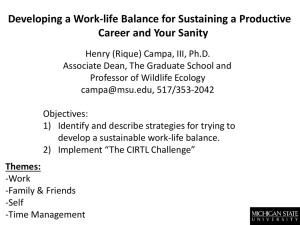
PowerPoint Presentation
to Accompany Chapter 15 of
Management
Canadian Edition
Schermerhorn Wright
Prepared by: Michael K. McCuddy
Adapted by: Lynda Anstett & Lorie Guest
Published by: John Wiley & Sons Canada, Ltd.
Planning Ahead — Chapter 15 Study Questions
How do we understand people at work?
What should we know about work attitudes and
behavior?
What are the alternative approaches to job design?
How can jobs be enriched?
How can work be scheduled to improve work-life
balance?
Management - Chapter 15
2
Study Question 1: How do we understand
people at work?
Basic background on work …
– Work can be a “turn-on” or a “turn-off.”
– People may work under conditions that don’t
provide satisfaction but this it doesn’t have
to be this way..
– Valuing people and creating jobs and work
environments that respect people’s needs and
potential will benefit everyone.
Management - Chapter 15
3
Study Question 1: How do we understand
people at work?
Organizational behavior
– The study of individuals and groups in organizations.
– Major foundations of OB:
•
•
•
•
Interdisciplinary body of knowledge.
Use of scientific methods.
Focus on practical applications.
Contingency thinking.
– Person-job fit:
• A very important contingency issue.
• Having a good match of individual interests and capabilities
with job characteristics.
Management - Chapter 15
4
Study Question 1: How do we understand
people at work?
Psychological contract
– Person-job fit begins here.
– A set of expectations held by an individual
about what will be given and received in the
employment relationship.
– An ideal work situation is one with a fair
psychological contract.
• Balance of contributions and inducements.
Management - Chapter 15
5
Figure 15.1 Components in the
psychological contract.
Management - Chapter 15
6
Study Question 1: How do we understand
people at work?
Quality of work life (QWL):
– The overall quality of human experiences in the
workplace.
– An important component of quality of life.
Poor management practices can diminish QWL
and overall quality of life.
Managers should create work environments
wherein people have positive experiences and
perform well.
Management - Chapter 15
7
Study Question 1: How do we understand
people at work?
“Big Five” personality traits:
– Extroversion.
• The degree to which someone is outgoing, sociable,
and assertive.
– Agreeableness.
• The degree to which someone is good-natured,
cooperative, and trusting.
– Conscientiousness.
• The degree to which someone is responsible,
dependable, and careful.
Management - Chapter 15
8
Study Question 1: How do we understand
people at work?
“Big Five” personality traits (cont.):
– Emotional stability.
• The degree to which someone is relaxed, secure, and
unworried.
– Openness.
• The degree to which someone is curious, receptive
to new things, and open to change.
Management - Chapter 15
9
Study Question 1: How do we understand
people at work?
Other personality traits that affect work behavior:
– Locus of control.
• The extent to which people believe they are in control of their
destinies versus believing that that what happens to them is
beyond their control.
– Authoritarianism.
• The degree to which a person defers to authority and accepts
status differences.
– Machiavellianism.
• The extent to which someone is emotionally detached and
manipulative in using power.
Management - Chapter 15
10
Study Question 1: How do we understand
people at work?
Other personality traits that affect work
behavior (cont.):
– Problem-solving styles.
• The ways people gather and evaluate information
for decision making. .
– Self-monitoring.
• The degree to which someone is able to adjust and
modify behavior in response to the situation and
external factors.
Management - Chapter 15
11
Figure 15.2 The “Big Five” and five more personality
dimensions that influence human behavior at work.
Management - Chapter 15
12
Study Question 2: What should we know
about work attitudes and behavior?
Attitude.
– A predisposition to act in a certain way toward people
and things in one’s environment.
Components of attitudes:
– Cognitive component.
– Affective or emotional component.
– Behavioral component.
Cognitive dissonance.
– The discomfort a person feels when attitudes and
behavior are inconsistent.
Management - Chapter 15
13
Study Question 2: What should we know
about work attitudes and behavior?
Job satisfaction.
– The degree to which an individual feels positively or
negatively about various aspects of work.
– Common aspects of job satisfaction:
•
•
•
•
•
•
Pay.
Coworkers.
Supervision.
Work setting.
Advancement opportunities.
Workload.
Management - Chapter 15
14
Study Question 2: What should we know
about work attitudes and behavior?
Strong and positive relationship between
satisfaction and absenteeism and turnover.
Satisfaction-related concepts having quality of
work life implications …
– Job involvement
• The extent to which an individual is dedicated to a job.
– Organizational commitment
• Loyalty of an individual to the organization.
Management - Chapter 15
15
Study Question 2: What should we know
about work attitudes and behavior?
Job performance.
The quantity and quality of task accomplishments by
an individual or group at work.
Individual performance equation:
– Performance begins with ability.
– Performance requires support.
– Performance involves effort.
Performance = Ability x Support x Effort
Management - Chapter 15
16
Study Question 3: What are the alternative
approaches to job design?
Job.
– A collection of tasks performed in support of
organizational objectives.
Job design.
– The process of creating or defining jobs by assigning
specific work tasks to individuals and groups.
Jobs should be designed so that both performance
and satisfaction result.
Management - Chapter 15
17
Study Question 3: What are the alternative
approaches to job design?
Job design alternatives:
– A good job provides a good fit between the
individual worker and task requirements.
– Vary along a continuum ranging from high to
low task specialization.
• High specialization job simplification
• Moderate specialization rotation and enlargement
• Low specialization job enrichment
Management - Chapter 15
18
Figure 15.3 A continuum of job design
alternatives.
Management - Chapter 15
19
Study Question 3: What are the alternative
approaches to job design?
Job simplification.
– Standardizing work procedures and employing
people in well-defined and highly specialized
tasks.
– Simplified jobs are narrow in job scope and low
in job depth.
– Automation.
• Total mechanization of a job.
• Most extreme form of job simplification.
Management - Chapter 15
20
Study Question 3: What are the alternative
approaches to job design?
Potential advantages of
job simplification:
– Easier and quicker
training of workers.
– Workers are less
difficult to supervise.
– Workers are easier to
replace.
– Development of
expertise in doing
repetitive tasks.
Potential disadvantages
of job simplification:
– Productivity suffers.
– Cost increases due to
absenteeism/turnover
of unhappy workers.
– Poor performance may
result from worker
boredom/alienation.
Management - Chapter 15
21
Study Question 3: What are the alternative
approaches to job design?
Job rotation and job enlargement:
– Expands job scope.
– Job rotation.
• Increases task variety by periodically shifting workers among
jobs involving different task assignments.
– Job enlargement.
• Increases task variety by combining two or more tasks
previously assigned to separate workers.
• Horizontal loading.
Management - Chapter 15
22
Study Question 3: What are the alternative
approaches to job design?
Job enrichment.
– Building more opportunities for satisfaction
into a job by expanding its content.
– Expands both job scope and job depth.
– Frequently accomplished through vertical
loading.
Management - Chapter 15
23
Study Question 3: What are the alternative
approaches to job design?
Checklist for enriching jobs:
– Remove controls that limit people’s discretion in their
work.
– Grant people authority to make decisions about their
work.
– Make people understand their accountability for results.
– Allow people to do “whole” tasks or complete units of
work.
– Make performance feedback available.
Management - Chapter 15
24
Study Question 4: How can jobs be enriched?
Core characteristics model …
– Contingency approach to job design
– Model focuses on:
•
•
•
•
Core job characteristics
Critical psychological states
Job outcomes
Moderating variables
– A job high in the core characteristics is
enriched.
Management - Chapter 15
25
Figure 15.4 Job design and individual work outcomes using
the core characteristics model.
Source: Reprinted by permission from J. Richard Hackman and Greg R. Oldham, Work Redesign
(Reading, MA: Addison-Wesley, 1980), p. 90.
Management - Chapter 15
26
Study Question 4: How can jobs be enriched?
Core job characteristics:
– Skill variety.
– Task identity.
– Task significance.
– Autonomy.
– Feedback.
Management - Chapter 15
27
Study Question 4: How can jobs be enriched?
Critical psychological states:
– Experienced meaningfulness of work.
– Experienced responsibilities for work
outcomes.
– Knowledge of actual results of work activities.
Management - Chapter 15
28
Study Question 4: How can jobs be enriched?
Job outcomes:
– High internal work motivation.
– High growth satisfaction.
– High general job satisfaction.
– High work effectiveness.
Management - Chapter 15
29
Study Question 4: How can jobs be enriched?
Moderating variables:
– Growth-need strength (GNS).
• People with high GNS will respond most positively
to enriched jobs.
– Knowledge and skills.
– Context satisfactions.
Management - Chapter 15
30
Study Question 4: How can jobs be enriched?
Improving core job characteristics:
– Form natural units of work.
– Combine tasks.
– Establish client relationships.
– Open feedback channels.
– Practice vertical loading.
Management - Chapter 15
31
Study Question 4: How can jobs be enriched?
Technology and job enrichment:
– Socio-technical systems.
• Job design that uses technology to best advantage
while still treating people with respect, and allowing
their human talents to be applied to the fullest
potential.
– Robotics.
• Use of computer controlled machines to completely
automate work tasks.
Management - Chapter 15
32
Study Question 4: How can jobs be enriched?
Questions for reflecting on job enrichment:
– Is it expensive to do job enrichment?
– Will people demand more pay for doing
enriched jobs?
– Should everyone’s job be enriched?
– What do the unions say about job enrichment?
Management - Chapter 15
33
Study Question 5: How can work be
scheduled to improve work-life balance?
Compressed workweek.
– Any work schedule that allows a full-time job to be
completed in less than the standard 5 days of 8-hour
shifts.
– Benefits — more leisure time, lower commuting costs,
lower absenteeism, and potentially improved
performance.
– Disadvantages — increased fatigue, family adjustment
problems, increased scheduling problems, possible
customer complaints, and union opposition.
Management - Chapter 15
34
Study Question 5: How can work be
scheduled to improve work-life balance?
Flexible working hours.
– Any work schedule that gives employees some
choice in the pattern of their daily work hours.
• Core time — all employees must be at work.
• Flextime — allows employees to schedule
around personal and family responsibilities.
Management - Chapter 15
35
Study Question 5: How can work be
scheduled to improve work-life balance?
Potential benefits of flexible working hours:
– People have greater autonomy in work
scheduling while ensuring maintenance of work
responsibilities.
– Organizations can attract and retain employees
who have special non-work responsibilities.
– Worker morale may be improved.
Management - Chapter 15
36
Figure 15.5 A sample flexible working
hours schedule.
Management - Chapter 15
37
Study Question 5: How can work be
scheduled to improve work-life balance?
Job sharing.
– One full-time job is split between two or more
persons.
Work sharing.
– An agreement between employees to cut back
their work hours to avoid layoffs or
termination.
Management - Chapter 15
38
Study Question 5: How can work be
scheduled to improve work-life balance?
Potential advantages of work sharing:
– Trained and loyal workers can be retained while
temporarily cutting labor costs.
– Continued work but with reduced earnings for
those who would otherwise be laid off.
Potential disadvantages of work sharing;
– Employees who might otherwise be protected by
seniority may suffer an income loss.
Management - Chapter 15
39
Study Question 5: How can work be
scheduled to improve work-life balance?
Telecommuting.
– A work arrangement that allows a portion of
scheduled work hours to be completed outside
of the office.
– Hoteling.
– Virtual offices.
Management - Chapter 15
40
Study Question 5: How can work be
scheduled to improve work-life balance?
Potential advantages of telecommuting:
– Freedom from …
•
•
•
•
–
–
–
–
Constraints of commuting.
Fixed hours.
Special work attire.
Direct contact with supervisors.
Increased productivity.
Fewer distractions.
Being one’s own boss.
Having more personal time.
Management - Chapter 15
41
Study Question 5: How can work be
scheduled to improve work-life balance?
Potential disadvantages of telecommuting:
–
–
–
–
–
–
–
Working too much.
Having less personal time.
Difficulty in separating work and personal life.
Less time for family.
Feelings of isolation.
Loss of visibility for promotion.
Difficulties supervising work-at-home employees from
a distance.
Management - Chapter 15
42
Study Question 5: How can work be
scheduled to improve work-life balance?
Part-time work.
– Work done on any schedule less than the
standard 40-hour workweek and does not
qualify person as a full-time employee.
– Contingency workers
• Part-time workers who supplement the full-time
workforce, often on a long-term basis.
• Now constitute 30 percent of the American
workforce.
Management - Chapter 15
43
Study Question 5: How can work be
scheduled to improve work-life balance?
Implications of part-time work:
– Provides employers with flexibility in
controlling labor costs and dealing with cyclical
labor demands.
– Temporary workers may lack commitment and
be less productive.
– Contingency workers are often paid less and
don’t receive important fringe benefits.
Management - Chapter 15
44
COPYRIGHT
Copyright © 2007 John Wiley & Sons Canada, Ltd. All rights
reserved. Reproduction or translation of this work beyond that
permitted by Access Copyright (The Canadian Copyright Licensing
Agency) is unlawful. Requests for further information should be
addressed to the Permissions Department, John Wiley & Sons
Canada, Ltd. The purchaser may make back-up copies for his or her
own use only and not for distribution or resale. The author and the
publisher assume no responsibility for errors, omissions, or damages
caused by the use of these programs or from the use of the
information contained herein.






